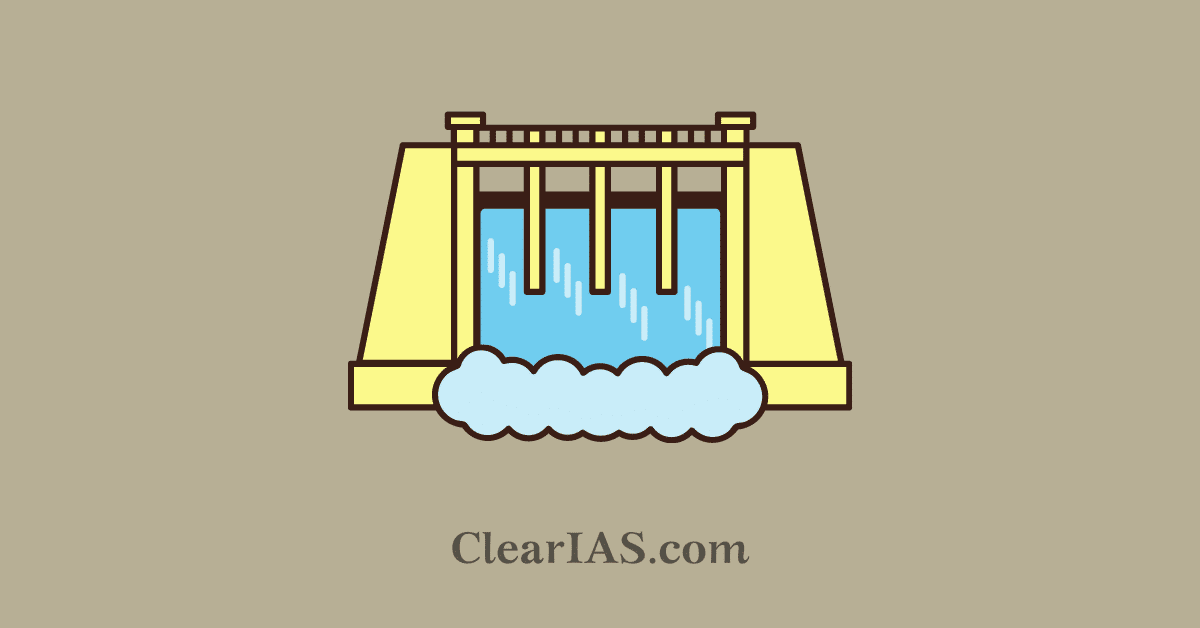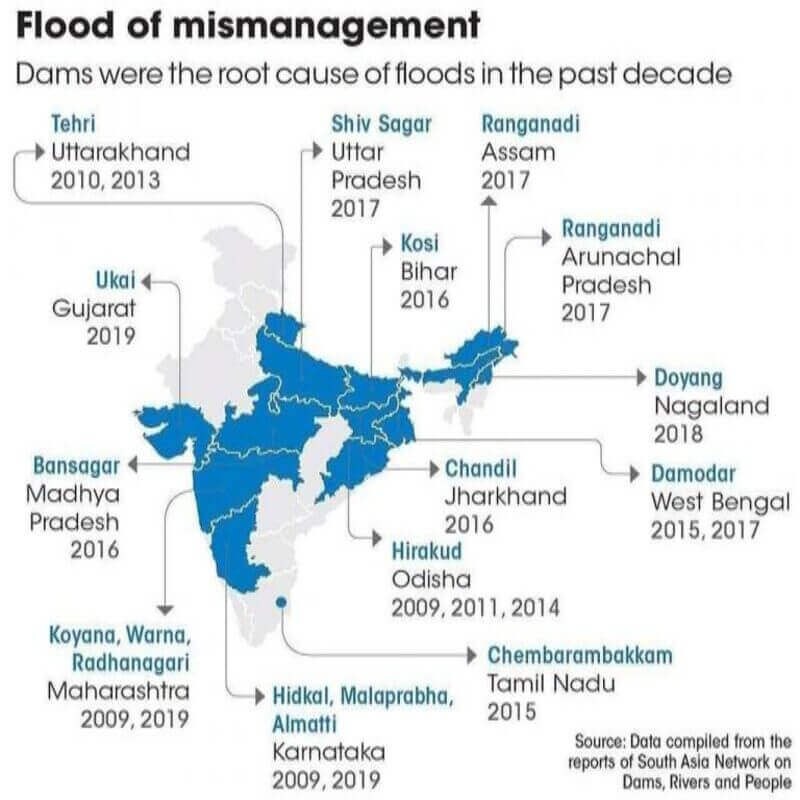 What is the Dam Safety Act 2021? What are the concerns regarding dams in India? What is the importance of dams? Read to know more.
What is the Dam Safety Act 2021? What are the concerns regarding dams in India? What is the importance of dams? Read to know more.
The dam safety bill 2019 has been passed in the winter session of parliament, making it the dam safety act, 2021.
- The constitutional validity of the Dam safety act has been challenged in the high court.
Also read: State of Indian Dams
What is the Dam Safety Act 2021?
“An Act to provide for the surveillance, inspection, operation, and maintenance of the specified dam for prevention of dam failure related disasters and to provide for an institutional mechanism to ensure their safe functioning and for matters connected therewith or incidental thereto.”
Features of the act:
- The National Committee on Dam Safety will be constituted and will be chaired by the chairperson, Central Water Commission. Functions of the committee will include formulating policies and regulations regarding dam safety standards and prevention of dam failures, analyzing the causes of major dam failures, and suggesting changes in dam safety practices.
- The act also ideates setting up a National Dam Safety Authority (NDSA) to be headed by an officer, not below the rank of an Additional Secretary, to be appointed by the central government. The main task of this authority includes implementing the policies formulated by the National Committee on Dam Safety, resolving issues between State Dam Safety Organisations (SDSOs), or between an SDSO and any dam owner in that state, specifying regulations for inspection and investigation of dams.
- The NDSA will also provide accreditation to agencies working on construction, design, and alteration of dams.
- The act also envisages constituting a State Dam Safety Organisation (SDSO) whose functions will be to keep perpetual surveillance, inspection, monitoring the operation and maintenance of dams, keeping a database of all dams, and recommending safety measures to owners of dams.
- The owners of the specified dams are required to provide a dam safety unit in each dam. This unit will inspect the dams before and after the monsoon session, and during and after any calamity or sign of distress.
- Dam owners will be required to prepare an emergency action plan, and carry out risk assessment studies for each dam at specified regular intervals.
- Dam owners will also be required to conduct a comprehensive dam safety evaluation of each dam, at regular intervals, through a panel of experts.
- The act provides for two types of offences – obstructing a person in the discharge of his functions, and refusing to comply with directions issued under the proposed law.
Importance of dams:
The Dams and Reservoirs world over have been playing a dual role:
- Harnessing the river water for accelerating socio-economic growth; and,
- Mitigating the calamities like floods and droughts faced by a large population of the world.
Dams and Reservoirs also fulfil the basic human needs like Water for Drinking and Industrial use; Irrigation for agricultural operations; Flood Control; Hydro Power generation; and, Inland Navigation, etc.
Construction of dams comes with its fair share of disadvantages also-
- Resettlement and Rehabilitation of displaced communities;
- Impact on the Environment and Forests;
- Sedimentary issues;
- Socio-economic issues; and,
- Safety aspects.
The above problems related to the construction of dams can be resolved successfully by dynamic, progressive, and responsive management.
Dams in India:
Major stress was placed on the construction of big power projects since the first five-year plan under Prime Minister Nehru. Nehru is said to have described big dams as, Modern Temples of India.
India is one of the biggest dam builders in the world, next only to the United States & China. As of June 2019, India has 5,745 large dams, including dams under construction. Of these, 5,675 large dams are operated by states, 40 by Central Public Sector Undertakings, and 5 by Private Agencies.
In India, dams higher than 15 meters or between 10-15 meters in height, that fulfil certain additional design conditions, are termed large dams.
Over 75% of these dams are more than 20 years old, and about 220 dams are more than 100 years old. Most of these large dams are in Maharashtra (2394), Madhya Pradesh (906), and Gujarat (632).

Need for the dam safety act:
Ageing of Dams:
As the dams become old, their design and hydrology do not remain at par with the latest understanding and practices. Huge siltation is taking place as a result of which the water holding capacity of dams is getting reduced.
Dependent on Dam Managers:
The regulation of dams is entirely dependent upon individual dam managers. There is no proper system and understanding in terms of the downstream water requirement.
Other factors:
Dam safety is dependent upon other factors such as landscape, land-use change, patterns of rainfall, structural features, etc.
Failures:
In the absence of a proper dam safety framework, shortcomings may get involved in the investigation, design, construction, operation, and maintenance of dams which might lead to serious incidents and sometimes dam failure.
Since the failure of the Tigra dam (Madhya Pradesh) in 1917, about 40 large dams are reported to have failed so far. The most recent case of failure of the Annamayya dam (Andhra Pradesh) in November 2021 is reported to have led to the death of 20 people.
Constitutional Validity of the dam safety act:
Water is under the state list (Entry 17), but the Centre has brought the legislation under Article 246 of the Constitution read with Entry 56 and Entry 97 of the Union list.
- State List, Entry 17: Water, that is to say, water supplies, irrigation and canals, drainage and embankments, water storage, and water power subject to the provisions of entry 56 of List I.
- Entry 56 of List I allows Parliament to make laws on the regulation of inter-state rivers and river valleys if it declares such regulation to be expedient in the public interest.
Article 246 empowers Parliament to legislate on any matter enumerated in List I of the Union List in the Seventh Schedule of the Constitution.
Entry 97 allows Parliament to legislate on any other matter not enumerated in List II or List III including any tax not mentioned in either of those Lists.
Way forward:
The recent catastrophes have shown how important dam safety regulations are and how it depends on many external factors such as ecology, hydrology, etc. Hence a holistic approach is the need of the hour in which experts from all the concerned areas should be involved.
Furthermore, building large dams is proving to be a more environmentally damaging and costly affair than the gains it provides, hence ecological sensitivity should be taken into consideration from now onwards.
Dam failure results in loss of lives and property at an unimaginable scale and nothing can compensate for that, thus three must be uniform in the laws and regulations related to dams at the national level.
Dam Rehabilitation and Improvement Project (DRIP) to improve safety and operational performance of selected dams, along with institutional strengthening with a system-wide management approach was launched by the government, which is a step in the right direction.






Leave a Reply